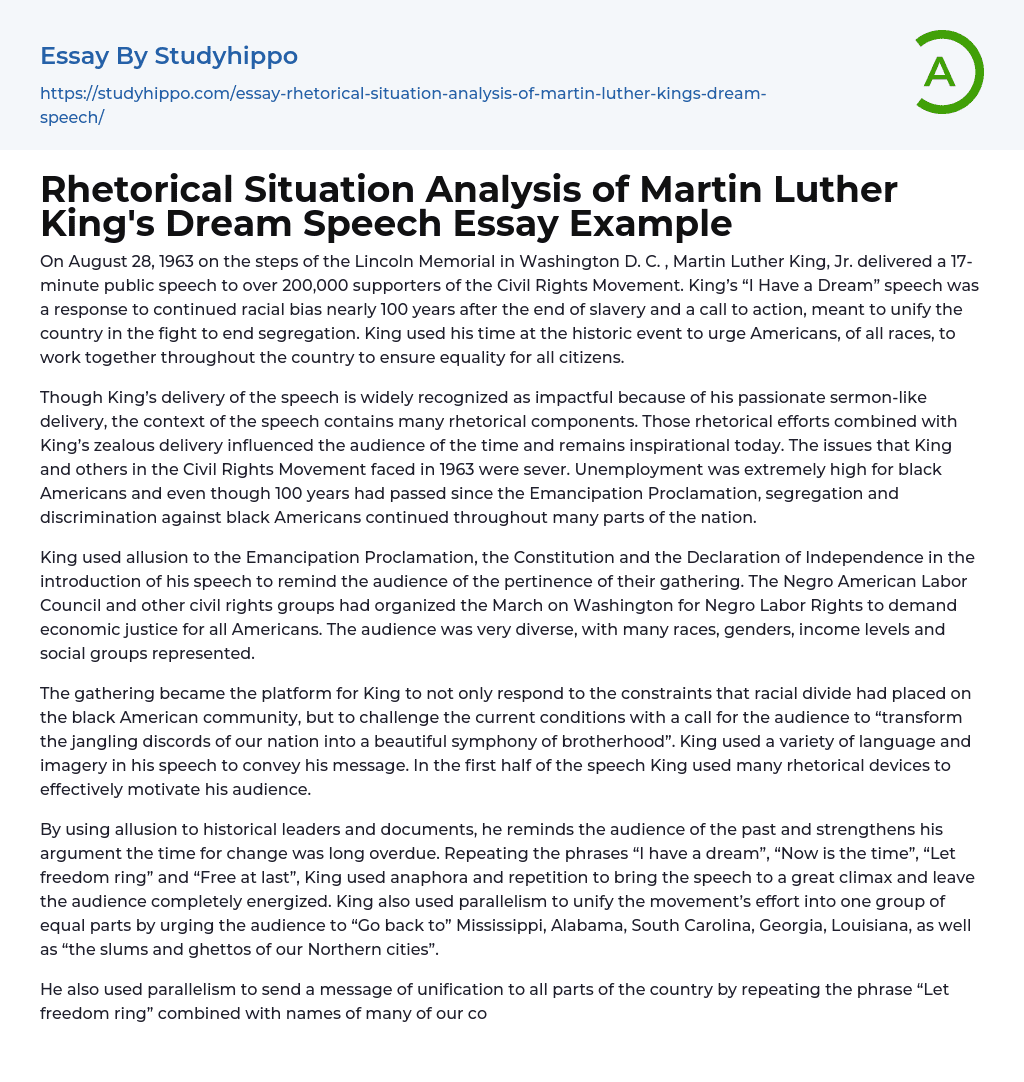

Rhetorical Situation Analysis of Martin Luther King’s Dream Speech Essay Example
On August 28, 1963 on the steps of the Lincoln Memorial in Washington D. C. , Martin Luther King, Jr. delivered a 17-minute public speech to over 200,000 supporters of the Civil Rights Movement. King’s “I Have a Dream” speech was a response to continued racial bias nearly 100 years after the end of slavery and a call to action, meant to unify the country in the fight to end segregation. King used his time at the historic event to urge Americans, of all races, to work together throughout the country to ensure equality for all citizens.
Though King’s delivery of the speech is widely recognized as impactful because of his passionate sermon-like delivery, the context of the speech contains many rhetorical components. Those rhetorical efforts combined with King’s zealous delivery influenced the audience of the time and remains inspirationa
...l today. The issues that King and others in the Civil Rights Movement faced in 1963 were sever. Unemployment was extremely high for black Americans and even though 100 years had passed since the Emancipation Proclamation, segregation and discrimination against black Americans continued throughout many parts of the nation.
King used allusion to the Emancipation Proclamation, the Constitution and the Declaration of Independence in the introduction of his speech to remind the audience of the pertinence of their gathering. The Negro American Labor Council and other civil rights groups had organized the March on Washington for Negro Labor Rights to demand economic justice for all Americans. The audience was very diverse, with many races, genders, income levels and social groups represented.
The gathering became the platform for King to not only
respond to the constraints that racial divide had placed on the black American community, but to challenge the current conditions with a call for the audience to “transform the jangling discords of our nation into a beautiful symphony of brotherhood”. King used a variety of language and imagery in his speech to convey his message. In the first half of the speech King used many rhetorical devices to effectively motivate his audience.
By using allusion to historical leaders and documents, he reminds the audience of the past and strengthens his argument the time for change was long overdue. Repeating the phrases “I have a dream”, “Now is the time”, “Let freedom ring” and “Free at last”, King used anaphora and repetition to bring the speech to a great climax and leave the audience completely energized. King also used parallelism to unify the movement’s effort into one group of equal parts by urging the audience to “Go back to” Mississippi, Alabama, South Carolina, Georgia, Louisiana, as well as “the slums and ghettos of our Northern cities”.
He also used parallelism to send a message of unification to all parts of the country by repeating the phrase “Let freedom ring” combined with names of many of our country’s mountain ranges, just as in the song “America” by Samuel Francis Smith (My Country! ‘Tis of Thee). Perhaps it was King’s use of metaphors that made the speech draw in the audience. He described the circumstances of racism and inequality with phrases descriptive of slavery including “flames of withering injustice”, “chains of discrimination” which connected the audience to their past while inspiring them to change their future.
style="text-align: justify">One year after delivering “I Have a Dream”, King’s work and message of equality for all was recognized with the Nobel Peace Prize. Not only did the award recognize his work for civil rights, but it was sign of worldwide sentiment that King’s message of peaceful change was working to change conditions of discrimination. King’s use of rhetorical devices to spread his message impacted not only the audience on the National Mall and those Americans who heard the speech broadcast on radio and television, but inspired action against discrimination across the nation and the world.
His appeal was so powerful because of the both the way he delivered the message and the rhetorical devices he used to enhance the speech’s content. The March on Washington and the reaction to King’s speech was so strong that President Kennedy and Vice President Johnson met with civil rights leaders to discuss anti-discrimination legislation. Although King was assassinated in 1968, he did live to see the passage of the Civil Rights Act of 1964 and the Voting Rights Act of 1965, both testaments that his dream was coming true. ?
- My Dream essays
- My Dream Job essays
- Euthanasia essays
- Assisted Suicide essays
- Censorship essays
- Gun Control essays
- Empowerment essays
- Civil Rights essays
- Capital Punishment essays
- Death Penalty essays
- Human Trafficking essays
- Sex Trafficking essays
- Gay Marriage essays
- Affirmative Action essays
- Child Labour essays
- Privacy essays
- Speech essays
- Child Protection essays
- Corporal Punishment essays
- Police Brutality essays
- Gun essays
- Death Penalty Pros And Cons essays
- Is The Death Penalty Effective essays
- The victim essays
- Public Speaking essays
- Freedom Of Speech essays
- Free Speech essays
- Persuasive Speech essays
- Gettysburg Address essays
- Informative Speech essays
- Adaptation essays
- Adventure essays
- Adversity essays
- Aging essays
- Alcohol essays
- Barbie Doll essays
- Beauty essays
- Care essays
- Carpe diem essays
- Change essays
- Chess essays
- Chicken essays
- Choices essays
- Contrast essays
- Crops essays
- Development essays
- Dream essays
- Evil essays
- Experience essays
- Family essays


Unfortunately copying the content is not possible
Tell us your email address and we’ll send this sample there.
By continuing, you agree to our Terms and Conditions.

